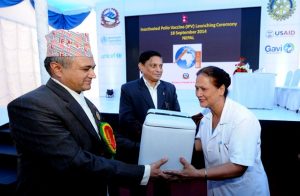IPV is rolled out globally
International support critical to protecting children everywhere against lifelong polio paralysis

2015 marks the year of one of the largest globally-coordinated vaccine introduction projects in history. Inactivated polio vaccine (IPV) will be introduced into more than 120 countries currently using only oral polio vaccine (OPV), in advance of the phased removal of OPVs in 2016. While OPV is extremely safe and has led the world to the threshold of being polio-free, on very rare occasions, its use can lead to vaccine-associated cases. For this reason, the global eradication of polio requires the cessation of all OPV use, once polio has been eradicated. IPV will at that time be the only option for countries to maintain immunity levels.
The global IPV introduction effort got underway in late 2014 – the Philippines, Vietnam and Tunisia just some of the countries introducing IPV, with countries across Asia-Pacific scheduled to follow in the first few months of 2015. The world is closely watching the experiences of introducing this vaccine in the Western Pacific, as this Region has a long history of leadership on polio eradication. The successful strategies first developed, trialled and taken to scale here are helping inform the eradication strategies in the remaining polio-affected countries of the world.
Now, the Region is again showing its leadership, and lessons learned here will help inform countries’ introduction plans elsewhere. The aim is to ensure that all children – no matter where they live – can be protected from lifelong polio paralysis. Because introducing a new vaccine into the routine immunization programme is no easy feat, it’s also about getting vaccines to the right place, at the right time, in the right condition.
The successful introduction of IPV in countries such as Nepal, Philippines and Vietnam, supported by WHO and UNICEF, shows that high level political commitment is a critical factor, filtering through to bolster many aspects of the programme. In all three countries, cold-chain capacity was reviewed and expanded ahead of the introductions, health workers were trained and equipped with updated data collection tools, and communities mobilized.
The introduction of IPV is also being used as an opportunity to evaluate broader routine immunization services in targeted countries, and to identify potential operational gaps which can now be addressed. For example, countries are taking advantage of the focus on IPV introduction to adapt community awareness materials, to update registers and forms comprehensively, and to expand health worker trainings. Such system strengthening efforts are helping to ensure that all children are not only protected by IPV against polio, but indeed will be even more comprehensively reached with all vaccine-preventable diseases.
All of this is part of the comprehensive Polio Endgame Plan, designed to secure a lasting polio-free world by 2018. Implementation of the Endgame Plan would not be possible without the critical and ongoing support of the international development community, including Australia, Japan, Norway, the United Kingdom, the Bill & Melinda Gates Foundation and Rotary International. Without these vital contributions, activities outlined in the Polio Endgame Plan could not be financed, and could not be implemented. It will ensure that no child will ever again be paralysed by polio, and that the world can reap savings upwards of US$50 billion over the next 20 years (mostly in developing countries).
It is a perfect example of aid dollars in action – helping secure a lasting polio-free world, that will be a gift for all future generations to come.













